Click on images to enlarge

habit during the wet season (Photo: Sheldon Navie)
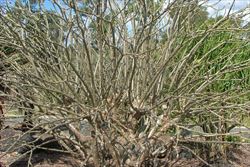
habit during the dry season (Photo: Sheldon Navie)

leaves (Photo: Sheldon Navie)
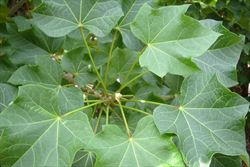
leaves (Photo: Sheldon Navie)
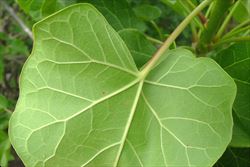
close-up of leaf underside (Photo: Sheldon Navie)

flower cluster (Photo: Sheldon Navie)

close-up of flowers (Photo: Sheldon Navie)

immature fruit (Photo: Sheldon Navie)
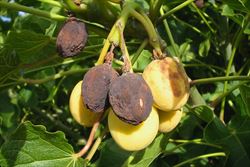
mature fruit (Photo: Sheldon Navie)
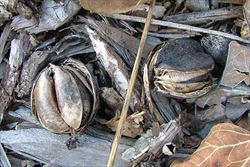
old fruit (Photo: Sheldon Navie)
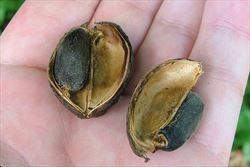
close-up of seeds (Photo: Sheldon Navie)
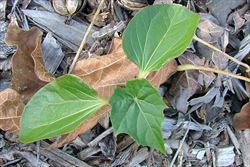
seedling (Photo: Sheldon Navie)

young plant (Photo: Sheldon Navie)
Scientific Name
Jatropha curcas L.
Synonyms
Curcas curcas (L.) Britt.
Family
Euphorbiaceae
Common Names
American purging nut, Barbados nut, Barbados purging nut, bed bug plant, big purge nut, black vomit nut, Brazilian stinging nut, Cuban physic nut, curcas bean, hell oil, physic nut, purge nut, purging nut, purging nut tree, tuba
Origin
Native to Mexico, the Caribbean, Central America (i.e. Belize, Costa Rica, El Salvador, Guatemala, Honduras and Nicaragua) and South America (i.e. Brazil, Bolivia, Peru, Argentina and Paraguay).
Cultivation
Physic nut (Jatropha curcas) was deliberately introduced into Australia at some time in the late 1800's. It has mainly been cultivated as a hedging plant or garden ornamental around mining sites and homesteads in the northern parts of Australia.
Naturalised Distribution
This species has a scattered distribution throughout the coastal and sub-coastal districts of northern and north-eastern Australia. It is most common in the north-western parts of the Northern Territory (particularly around Darwin) and in northern Queensland. It is occasionally also naturalised in the coastal regions of central and southern Queensland and is present in the inland regions of the Northern Territory. The two main infestations in the Northern Territory are located near Pine Creek and Kapalga.
Habitat
A weed of tropical and sub-tropical environments that is found in disturbed sites, pastures, open woodlands, waste areas, abandoned gardens and along roadsides.
Habit
An upright (i.e. erect) shrub or small tree usually growing 2-4 m tall. This species often loses its leaves during the dry season (i.e. it is deciduous).
Distinguishing Features
- an upright shrub or small tree usually growing 2-4 m tall.
- its stems are thick and exude a watery sap when broken.
- its alternately arranged leaves (10-19 cm long and 5-15 cm wide) have three or five broad and shallow rounded lobes.
- its small pale yellow to greenish flowers are borne in loose clusters in the forks of the upper leaves.
- its fleshy capsules (3-4 cm long) usually contain three large seeds and turn yellow and then dark brown as they mature.
Stems and Leaves
The older stems are thick and softly woody, with the younger ones are sometimes slightly hairy (i.e. puberulent).
The leaves are alternately arranged along the stems and borne on stalks (i.e. petioles) 6-14 cm long. They are relatively large (10-19 cm long and 5-15 cm wide) and smooth and shiny in appearance. These leaves have heart-shaped (i.e. cordate) bases and three or five shallow lobes with rounded or pointed tips (i.e. obtuse to acute apices).
Flowers and Fruit
The pale yellow to greenish coloured flowers are small and inconspicuous. They are borne in loose clusters on short stalks (i.e. peduncles) in the forks (i.e. axils) of the upper leaves or at the tips of the branches (i.e. in terminal or axillary panicles). Flowering occurs throughout the year, but is most abundant during the wet season.
The fruit is a fleshy capsule that is initially green in colour, but turns yellow and then dark brown as it matures. These fruit (3-4 cm long) are oval (i.e. ellipsoid) or almost round (i.e. sub-globular) in shape and usually contain three large seeds. The smooth textured seeds (17-20 mm long) are mostly brown or black in colour, with some fine yellow stripes. They are hard and slightly bean-shaped (i.e. reniform).
Reproduction and Dispersal
This species reproduces by seed and also vegetatively via suckers originating from the roots and crown.
Seeds may be spread short distances when they are explosively released, while most long range dispersal probably occurs in water or in mud adhering to animals and vehicles. The spread of this species is also aided by its deliberate cultivation in home gardens.
Environmental Impact
Physic nut (Jatropha curcas) is not a particularly aggressive weed, and tends to spread relatively slowly. However, it is drought resistant and will grow under a wide range of climatic and soil conditions. It is regarded as an environmental weed or potential environmental weed in many parts of northern Australia. Plants are usually found in disturbed areas, especially around abandoned homesteads and mines.
Physic nut (Jatropha curcas) competes with native species or pasture plants can eventually form dense thickets or colonies. If it is allowed to establish widespread populations over time, it may threaten some of Australia's rangeland communities. For example, it is regarded as posing a threat to biodiversity in the Einasleigh and Desert Uplands bioregion in inland northern Queensland.
Other Impacts
The fresh seeds are highly poisonous to humans, especially to children, and can be mistaken for peanuts. They are also toxic to livestock, though few instances of stock poisoning have been reported in Australia.
Physic nut (Jatropha curcas) competes with pasture plants and dense thickets may reduce pasture productivity. It may also act as an alternative host for insect pests of cotton crops.
Legislation
This species is declared under legislation in the following states and territories:
- Northern Territory: A - to be eradicated (throughout all of the Territory), and C - not to be introduced into the Territory.
- Western Australia: P1 - trade, sale or movement into the state prevented (throughout the entire state), and P5 - to be controlled on public and local government land (in the Broome, Derby-West Kimberley, Halls Creek and Wyndham-East Kimberley local authority areas).
Management
For information on the management of this species see the following resources:
- the Northern Territory Department of Natural Resources, Environment and The Arts Agnote on this species, which is available online at http://www.nt.gov.au/weeds.
Similar Species
Physic nut (Jatropha curcas) is very similar to bellyache bush (Jatropha gossypiifolia) and relatively similar to castor oil plant (Ricinus communis). These three species can be distinguished by the following differences:
- physic nut (Jatropha curcas) has leaves that are shallowly divided into 3-5 rounded lobes (i.e. they are palmately lobed) and hairless (i.e. glabrous). The small flowers have five greenish-yellow petals and are borne in small branched clusters. Its fruiting capsules are usually dull yellow and hairless (i.e. glabrous).
- bellyache bush (Jatropha gossypiifolia) has leaves that are deeply divided into 3-5 pointed lobes (i.e. they are palmately lobed) and covered in sticky hairs (i.e. glandular pubescent). The small flowers have five red petals and are borne in small branched clusters. Its fruiting capsules are usually bright glossy green and sometimes sparsely hairy (i.e. sparsely pubescent).
- castor oil plant (Ricinus communis) has leaves that are usually divided into 7-9 pointed lobes (i.e. they are palmately lobed) and hairless (i.e. glabrous). Separate male and female flowers (both lacking petals) are borne together in large elongated clusters (8-15 cm long), with the male flowers below the female flowers. Its immature fruiting capsules are densely covered in soft blunt spines, but are hairless (i.e. glabrous).

